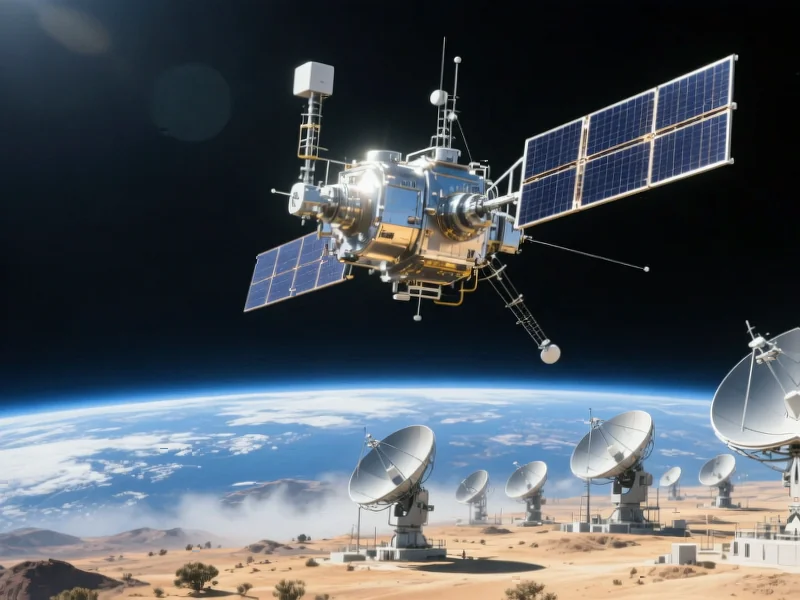According to SpaceNews, the U.S. Space Force is adopting a “government-owned, commercially-operated” (GOCO) satellite model driven by concerns about potential attacks on commercial space assets during conflicts and questions about financial responsibility when satellites become military targets. Executives revealed at the October 29 Milsat Symposium that this shift responds to developments like Russia declaring Western commercial satellites legitimate military targets if they support Ukraine. The Space Force has already implemented GOCO in programs including its MILNET low Earth orbit broadband constellation operated by SpaceX, along with Maneuverable Geosynchronous Orbit (MGEO) satellite services and the Protected Tactical Satcom – Global (PTS-G) program. Industry leaders noted that while GOCO protects companies from catastrophic financial losses by transferring asset ownership risk to the government, significant challenges remain around cybersecurity, indemnification frameworks, and procurement practices that could undermine the model’s effectiveness.
Table of Contents
A Fundamental Rethinking of Space Acquisition
The GOCO model represents the most significant evolution in military space acquisition since the establishment of the United States Space Force itself. What makes this particularly noteworthy is that it’s happening not during peacetime planning but in response to active threats in Ukraine, where commercial satellite capabilities have become contested domains. The traditional approach of simply purchasing commercial services leaves companies exposed to unacceptable risks in great power competition scenarios. More importantly, this shift acknowledges that the distinction between military and commercial space infrastructure has become increasingly blurred, requiring new contractual and operational frameworks that reflect this reality.
The Delicate Balance of Risk Transfer
While transferring financial risk from commercial operators to the government addresses immediate concerns about asset loss in conflict, it creates a different set of challenges. The government now bears the burden of insuring against war-related losses, which could prove enormously expensive given the high value of space assets and their vulnerability to emerging anti-satellite technologies. This risk calculus becomes even more complex when considering that adversaries may deliberately target these government-owned systems precisely because they’re now explicitly military assets rather than commercial infrastructure. The insurance industry has historically struggled with pricing space risk, and adding wartime exposure to the equation creates unprecedented challenges for both premium calculation and coverage availability.
The Expanding Cybersecurity Battlefield
The cybersecurity concerns highlighted in the SpaceNews report represent just the tip of the iceberg. When commercial operators take on government work, they immediately become high-value targets for state-sponsored hacking groups. These companies often lack the sophisticated cybersecurity infrastructure of traditional defense contractors, creating potential vulnerabilities in what the government now considers critical infrastructure. The ground station security issues mentioned are particularly concerning, as these facilities represent the most accessible points in the space architecture for physical and cyber attacks. As we’ve seen in other sectors, securing the supply chain and ensuring robust cybersecurity across commercial partners requires continuous monitoring and investment that may strain both government oversight capabilities and company resources.
The Persistent Procurement Problem
The tension between commercial standardization and military customization represents a fundamental challenge that GOCO alone cannot solve. Defense procurement has historically struggled with adapting to commercial innovation cycles, often demanding modifications that undermine the very advantages of commercial technology. The pattern described—where the Pentagon requests custom features that transform affordable commercial systems into expensive bespoke solutions—has plagued defense acquisition for decades. While some program offices are reportedly rethinking this approach, institutional inertia and risk-averse procurement regulations make meaningful change difficult. The success of GOCO will depend heavily on whether the Space Force can resist the temptation to over-customize and instead adapt military requirements to leverage commercial capabilities as they exist.
Broader Strategic Implications
This shift toward GOCO arrangements signals a broader recognition that future conflicts will extend into space domains with commercial players as essential participants. The model essentially creates a hybrid architecture where the lines between military and commercial space operations become intentionally blurred. While this provides operational flexibility, it also raises important questions about escalation dynamics and legal frameworks governing space conflict. If adversaries perceive that targeting commercial-operated government satellites constitutes an attack on military assets, the threshold for conflict escalation could lower significantly. Additionally, the international legal framework for space warfare remains underdeveloped, creating potential ambiguity about how these hybrid systems would be treated under existing treaties and conventions.
The Road Ahead for Space Partnerships
The success of the GOCO model will ultimately depend on whether both sides can navigate the inherent tensions between military requirements and commercial realities. The dual-use market prediction of significant growth over the next 10-20 years seems plausible, but it will require fundamental changes in how the defense establishment approaches technology acquisition. Companies that can successfully bridge the commercial-government divide will likely enjoy competitive advantages, but they’ll also need to invest heavily in security compliance, regulatory expertise, and risk management capabilities. The most successful players will be those that can maintain their commercial innovation cycles while meeting the rigorous demands of military customers—a balance that has proven elusive for many traditional defense contractors.
Related Articles You May Find Interesting
- The Respect Deficit: How Modern Workplaces Lost Their Humanity
- The Silent Siege: Why Your Smart Home Is Under Constant Attack
- Argentina’s Currency Crossroads: Why Milei Must Float the Peso Now
- The CFO’s New Mandate: Engineering Resilience Through Intelligent Risk
- Windows 11 Task Manager Bug Creates Zombie Processes



